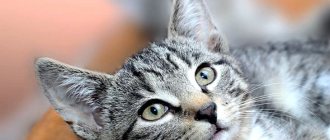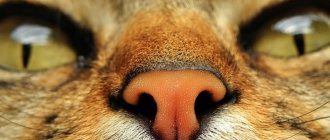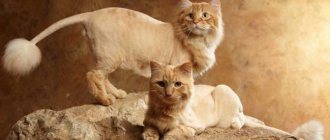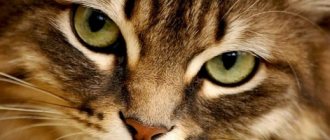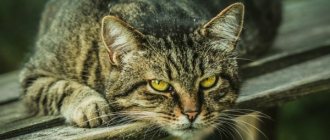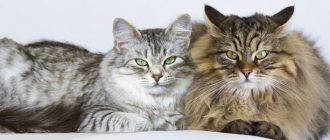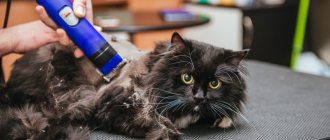Whiskers for cats are an extremely important attribute that performs not only a decorative role, but is necessary for orientation in space. Almost all predators and other mammals, as a result of evolutionary processes, acquired a similar unique “navigation” system. Whiskers allow cats to feel quite calm at night and not bump into objects.
Although whiskers are derivatives of the skin, such as fur, they are not exactly hair. There is an assumption that ancient cats had mustaches before thick fur appeared.
Tactile detectors, or as the cat's whiskers are also called, are thicker than the hairs of the coat. In complete darkness, when the animal’s vision does not allow it to distinguish objects, the mustache comes to the rescue. The specific vibration emanating from the mustache allows you to obtain detailed information about surrounding objects or a potential enemy. Tactile detectors play an extremely important role during a fight with relatives or during the hunt for prey.
Whiskers on cats and cats are located not only in the cheek area, as many owners believe. They are located in the eyebrows, chin and even on the forelimbs. A winning tactic is to line up during a fight by capturing the exact body position of a potential opponent.
What are whiskers on cats?
Scientifically, a cat's whiskers are called vibrissae. They are also called tactile hairs. By themselves, they do not feel anything, just like ordinary hairs. When the whiskers sense air movement or the animal touches something with them, they vibrate and stimulate the nerve cells located in the hair follicle. It is thanks to this feature that the vibrissae get their name.
Structure of a cat's whisker
Vibrissae are technically hairs, but they are much longer and thicker than normal hairs and are conical in shape. Compared to regular (guard) hairs, vibrissae have a larger follicle (bulb), which contains blood-filled sinuses (cavities), as well as nerve endings that connect to the somatosensory cortex - the part of the brain that is responsible for receiving and processing sensory sensations from different parts of the body.
Differences in the structure of wool and whiskers.
In many ways, whiskers perform their function by moving. Their movement is ensured by well-developed striated muscle tissue. And this is another difference from guard hairs, which are driven by smooth muscles.
Sense organ
We have learned since childhood that a person has developed 5 senses, which correspond to a certain part of the body. The animals are luckier. To the standard sense organs, an additional one is added, which is very important - the mustache. Not many people know what a cat's whiskers are called. Experts gave them a definition - vibrissae. The word comes from the Latin name vibrissae, which means “vibration”.
Whiskers are long hairs located near the animal's nose. They are quite rigid, but can break off. If the animal's fur provides thermal insulation, then the additional sense organ is directly connected to the nervous system and performs a tactile function.
What kind of whiskers do cats have?
The main part of the vibrissae grows on the muzzle. They come in different lengths and perform different functions.
Vibrissae are divided into the following groups:
- supraorbital (located above the eyes),
- buccal (located on the cheeks),
- mystical (located on the sides of the mouth),
- mandibular (located on the chin).
Mystical vibrissae are conventionally divided into macrovibrissae and microvibrissae. Macrovibrissae are long and thick whiskers that usually grow to the sides and are needed so that the pet can “scan” the space around the head. They grow in four rows symmetrically on both sides of the muzzle. Each cat's pattern is unique, just like a human's fingerprint.
Microvibrissae are usually short, easily confused with regular hair, and grow downwards. They have a similar function - to read space, but microvibrissae allow cats to examine objects in more detail, while simultaneously using their senses of smell and taste.
In addition to the whiskers on their faces, cats have carpal whiskers. They can be seen on the back of a cat's paws. They help domestic predators in hunting. When a cat has caught game, the whiskers on its paws help determine whether the prey is moving and whether it is alive or not.
How do cat whiskers work?
When cats touch an object with their whiskers, they catch its outline. Signals are transmitted to the brain using nerve endings that are located in the bulb of each mustache. There are 100-200 nerve cells per whisker.
Receptors transmit information to the brain about the direction, speed and duration of whisker movement. This is how cats read the location, size, texture of an object and other information.
Sense organ
We have learned since childhood that a person has developed 5 sense organs, which correspond to a certain part of the body. The animals are luckier. To the standard sense organs, an additional one is added, which is very important - the mustache. Not many people know what a cat's whiskers are called. Experts gave them a definition - vibrissae. The word comes from the Latin name vibrissae, which means “vibration”.
Whiskers are long hairs located near the animal's nose. They are quite rigid, but can break off. If the animal's fur provides thermal insulation, then the additional sense organ is directly connected to the nervous system and performs a tactile function.
Why does a cat need a mustache?
Now that we know how vibrissae work, it’s time to talk about why they are needed at all.
Cats are excellent hunters, their vision is 6-10 times sharper than humans. At the same time, they are farsighted and have difficulty seeing what is under their nose. Perhaps you noticed this when you treated your pet to a treat: you hold out your palm, on which lies an appetizing piece of yummy food, and she does not take it, but sniffs your palm, as if looking for this very piece. Don't you think the pet is really looking for a treat, and does this not only with the help of its nose, but also with the help of its whiskers. This is only one of the functions of the vibrissae.
Body position detection
Whiskers help cats determine the position of their body. The sense of one's own body is scientifically called proprioception. It is provided by proprioceptors, or sensory receptors. In cats, these receptors are located in the place where the whiskers grow. Receptors send information to the brain about the position of the body and limbs in space, thus helping the cat feel every part of its body. It is believed that this is why cats land on their feet in most cases.
Navigation
Another function of vibrissae is navigation. The whiskers are very sensitive to air vibrations and react to the slightest changes, they work like a radar.
When cats approach something in their path, they create vibrations in the air that bounce off the object. The animal picks up these vibrations with its whiskers and reads information about surrounding objects.
In the wild, this function helps determine the location of prey and relatives. This feature helps domestic cats navigate the house at night - cats can easily find bowls and toys in the dark and avoid obstacles.
Protection
Vibrissae protect. Cats' eyes are very sensitive; even a small speck of dust can damage them. When such a speck of dust falls on the whisker above the eye, the cat feels it, blinks and shakes its head to shake off the speck of dust.
When a cat walks and touches long blades of grass or branches of bushes with its whiskers, it understands where the obstacle and potential danger are, because a blade of grass can touch an eye, and a bush can have thorns. Vibrissae warn of danger and allow you to choose a safer direction.
Whiskers help avoid getting stuck in crevices. Their length, on average, corresponds to the width of the animal’s body. When a cat approaches a narrow place, such as a hole in a fence, the whiskers help determine whether it can fit through the hole. If the hole is much smaller than the width of the whiskers, the cat understands that it cannot fit through here.
Sometimes a cat's life depends on its whiskers - they help sense danger and determine where the enemy is.
Whiskers help cats hunt and recognize obstacles.
Communication
By the position of the whiskers, you can determine the mood of the pet. For example, when you play with your pet, you may notice that his whiskers point forward. This is because the animal is in hunting mode. When a cat is frightened, it seems to hide its whiskers - they are pressed against its cheeks. In general, when the pet is calm, the whiskers are also in a calm state. When something bothers a cat, it tenses and fluffs them up.
Other meanings of this word:
Random riddle:
Which clock shows the correct time only twice a day?
Random joke:
— How to put four elephants in “Zaporozhets”? - Two forward and two back. -Who will drive the car then? — An elephant who has a category “B” license. — Why do elephants go to the beach with tennis rackets? “They put them on their feet so they don’t fall into the sand.” — Why do ostriches stick their heads in the sand? — To talk to the elephants who use Chinese-made rackets. — How do you know that there is an elephant in the china shop? — A Zaporozhets is parked next to it. — Why don’t elephants use computers? - They are afraid of mice. — What is the difference between African and Indian elephants? — 3000 km. — What do elephants use as a vibration massager? - Epileptic pygmies. - Why do ducks have such wide legs? - To put out burning branches. - Why do elephants have such wide legs? - To put out burning ducks.
Did you know?
George Washington grew marijuana in his garden.
Scanwords, crosswords, sudoku, keywords online
Article source: https://scanword.org/word/20606/0/146181
Why do my mustaches fall out?
Hair loss is a normal process. Cats lose their whiskers in the same way as they lose their fur, this is a process of shedding. Normally, cats lose one or two whiskers at a time. You already know that they have many important functions, so they cannot all fall out at once - without whiskers, the cat will have a very difficult time. But it happens that the mustache falls out for other reasons.
Allergy
Losing mustaches may indicate an allergy. Cats' bodies often react to allergens with dermatological problems, such as skin irritation. Most often, mustache loss is a consequence of food allergies.
Infection
If an infection or fungus appears in the place where the whiskers grow, they can cause the whiskers to fall out. Bacterial infections such as ringworm can also cause hair loss.
Injuries
If the cat is injured in the place where the whiskers grow - for example, his whiskers and eyebrows are damaged - they may fall out. It's not just other animals that can cause injury. If a pet unsuccessfully rubs its muzzle against a tree or crashes into a wall in the midst of play, this can also cause it to fall out.
Cat acne
Cats, like people, get acne. Acne usually forms in the chin area. But it can spread to the cheeks and thus contribute to mustache loss. The main cause of acne is bacteria that grows on your cat's bowls. For prevention, it is better to use ceramic or metal bowls and wash them frequently.
Lost mustaches grow back. But if the loss is associated with veterinary problems, you need to solve these very problems first. Take your pet to a veterinarian, he will help determine the cause and select treatment if necessary.
Sometimes mustache loss is due to lack of nutrients. If the analysis shows that the animal is lacking something in its diet, it will have to be adjusted. The health of the coat and the whole body as a whole will be helped by providing SUPERPET species-typical nutrition. This food takes into account all the needs of cats and provides all the necessary macro- and microelements.
For your pet’s health, veterinarians recommend SUPERPET, a biologically appropriate diet.
Why do cats' whiskers break?
Vibrissae can not only fall out, but also break. This phenomenon can be observed especially often in kittens. There is no need to worry: most often this happens because kids are inquisitive and very actively explore the world around them. Kittens do not yet know how to fully coordinate their movements and calculate speed and strength, so they can fall, play roughly with each other or with toys, and even run into walls. All this can cause a broken mustache, but it will grow back over time.
This happens less often in adulthood. If you find a broken whisker on your pet, first analyze the situation: perhaps your pet has recently gotten really wild? Or did he jump unsuccessfully and fall? If this is a constant problem, you should consult a veterinarian - perhaps the cat lacks some nutrients in the body or is worried about parasites.
What happens if you cut a cat's whiskers?
The answer to the question of what will happen if you cut a cat's whiskers lies in understanding the functions that they perform. Without whiskers, the animal will experience extreme stress because its ability to navigate in space is impaired. The risk of injury increases: the pet cannot consider the space around itself in the usual way, cannot estimate the distance and because of this it can easily get stuck in a narrow place. This can be especially dangerous if you let your cat out for a walk. Stress and feelings of disorientation may cause your pet to become aggressive or hide in fear. That's why you can't cut a cat's whiskers.
Take care of this important organ of your pet:
- do not leave the cat alone near an open fire (be careful with candles!),
- Monitor how children play with your pet and, if necessary, explain that they should not pull its whiskers or cut them off,
- take proper care of the fur and try not to touch the whiskers when brushing the cat, this causes hyperstimulation of the receptors,
- do not use bowls with high edges that the whiskers can get caught on - some animals do not like this and may even refuse to eat,
- Monitor your cat's health and visit your veterinarian regularly.
If you suddenly happen to trim your pet’s mustache, don’t panic—new ones will grow in their place. But this takes time, and while they grow, the pet may behave restlessly due to discomfort. Therefore, during this period it is worth especially carefully monitoring the animal, taking into account its mood and providing it with maximum comfort.
